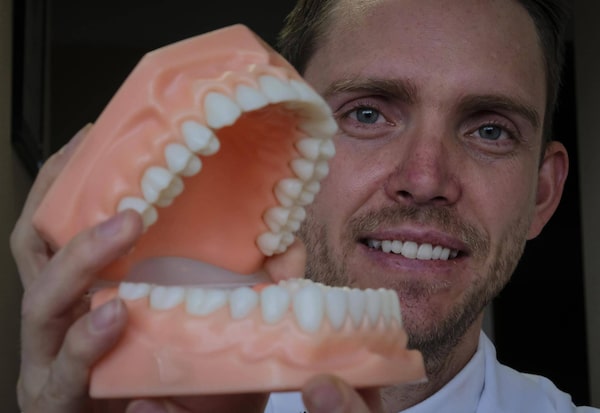
For those who want to practice dentistry in a city, ‘it’s an uphill battle,’ says Ben Greff, who ultimately bought a practice in Calgary.Jeff McIntosh/The Globe and Mail
Like many young dentists, Ben Greff, 33, graduated from the University of Alberta's school of dentistry in 2015 already several hundred thousand dollars in debt.
He landed his first job as an associate dentist at a rural practice in central Alberta, where he moved with his wife and four children. They were happy there, but Dr. Greff ultimately wanted to run his own practice, preferably in the city. "We're just more city-type people," he says.
That proved more difficult than he'd anticipated. Dental practice valuations in Canada's urban centres have soared in recent years. "I've noticed an astronomical leap even since I started looking then and now," says Dr. Greff, who did succeed in buying a practice in Calgary.
According to a 2014 report by the Canadian Dental Association, those rising prices are simply a function of supply and demand.
"Current work-force data suggest that there is an oversupply of dentists throughout most regions of Canada, and the current supply of dentists will continue to significantly outpace the population growth," the report notes.
A 2016 CDA study shows one dentist per 1,622 patients in Canada in 2015, compared with one for every 1,742 patients in 2005. And the problem is particularly acute in Canada's big cities, where the density of dentists "is now roughly three times that in rural areas," according to the association.
Both young professionals and the growing ranks of foreign-trained dentists "all seem to want to live in the city," says Henry Doyle, owner of Al Heaps & Associates Inc., a Vancouver-based brokerage that specializes in selling dental practices Canada-wide.
That has led to sometimes fierce competition for scarce patients. Today's practices routinely stay open seven days a week, often with extended hours. And they reach out to patients – rather than vice versa – either electronically or by phone to book appointments.
"You have a lot of dentists – especially young dentists – being very creative," says Dr. Greff, who does a Halloween-candy buyback to put his practice on potential patients' radar.
Some dentists even offer incentives such as free teeth whitening to get patients in the door. "You definitely see a more cut-throat mentality," says Dr. Greff.
The shortage of patients has the effect of making it "easier to buy an existing practice than to start from zero," says Mr. Doyle. The cost of equipment and leasehold improvements to start a new practice in downtown Toronto would run about $800,000 to $1-million, he says, "and that's before you even have one patient."
That means dentists starting from scratch can expect two or three years of negative cash flow before they turn a profit, says Mr. Doyle. In contrast, if you buy a going concern, "you've got cash flow from day one."
The result is that the average price of a dental practice has almost doubled in the past five years, says Graham Rosenberg, chief executive officer of Canada's biggest corporate dentistry player, Dental Corp. of Canada Inc., also known as Dentalcorp.
Prices are particularly high in Montreal, Toronto, Calgary and Vancouver, where dentists usually pay upward of $1-million for a going concern, says Mr. Doyle.
Historically low interest rates are another reason for the higher valuations. Dentists, Mr. Doyle says, can qualify for 100 per cent financing from the banks for their practices. "At a 2.7-per-cent interest rate with a great cash flow, dentists can afford to buy a lot of practice," he says.
Complicating matters further, a growing number of corporate dentistry groups and franchise operations have sparked competing bids for practices "sometimes 25 to 50 per cent over asking," says Mr. Doyle.
Although the proportion of corporate-owned practices in Canada is only about 3 per cent, it's growing rapidly. "In the States it's about 15 per cent," says Mr. Doyle. "And the prediction is that in the next five to 10 years it will be more like 30 to 50 per cent in both markets."
Mr. Rosenberg's Toronto-based company, for example, has acquired 220 practices across the country since its launch in 2011. Although the principal dentist remains in control, the firm handles the tasks dentists often don't enjoy, such as human resources, marketing, recruitment and administrative functions.
The structure can be appealing to those who don't want the headaches of running a business, or to dentist-owners who can "receive market value for their practice today and still maintain control," says Mr. Rosenberg.
Other dental business models include shared practices and dentists who invest in and run many offices – all of them in the market for scarce dental practices.
"If you get outside the major centres, the practices are a lot more profitable," says Mr. Doyle.
But for those who want to practice dentistry in a city, "it's an uphill battle," says Dr. Greff.
"You can still make a decent living, but this is a much more difficult industry to be part of than I thought it would be."